
Space at Expo 2020by Jeff Foust
|
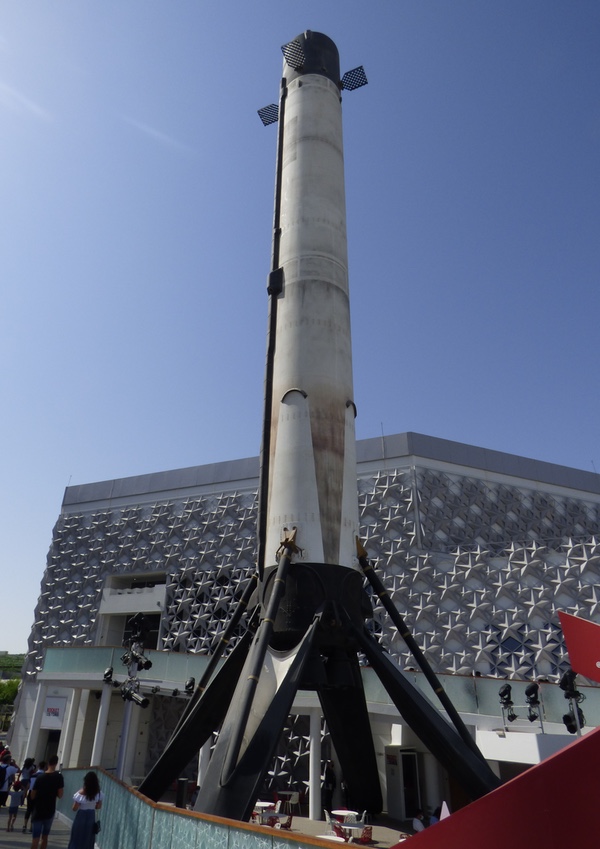 The replica Falcon 9 is complete with landing legs, grid fins, and the appearance of soot from past landings. (credit: J. Foust) |
Perhaps the most prominent space-related exhibit is at the relatively modest US pavilion. Standing outside in the back is a full-sized replica of a Falcon 9 booster, standing on its landing legs as if it had just landed there from a launch, its sides layered with a patina of soot to make it look like it’s been on a couple of flights already.
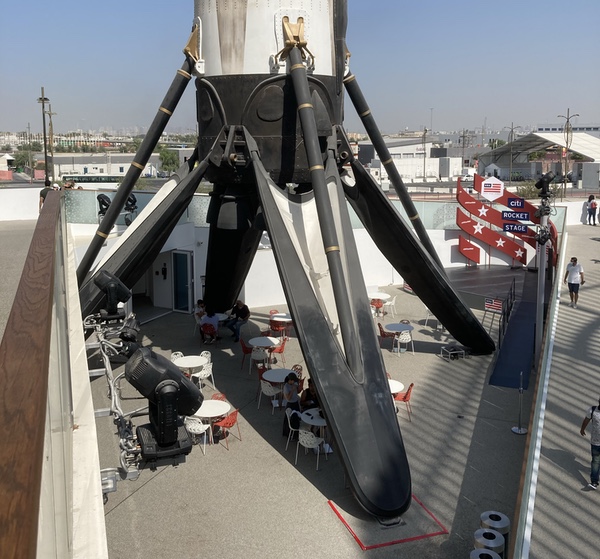 Dine in the shade of a booster while watching events on the Citi Rocket Stage. (credit: J. Foust) |
The booster stands above a patio, allowing people to dine underneath the booster with food they buy at the neighboring Rocket Diner, and perhaps watching performances on the adjacent Rocket Stage (sponsored by Citi.) You can also go to the Rocket Shop for souvenirs; there’s no SpaceX merchandise there but plenty of NASA logo apparel among with more generic USA-themed gifts.
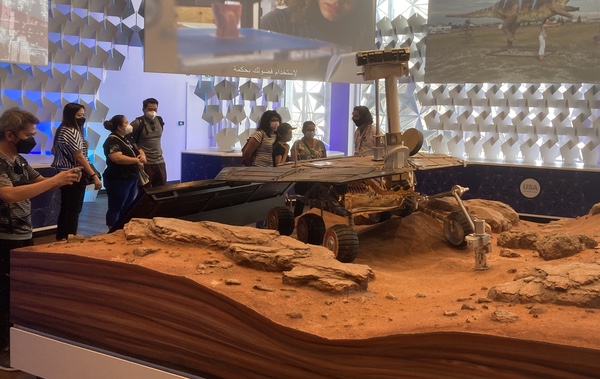 A model of a Mars Exploration Rover inside the US Pavilion. (credit: J. Foust) |
The Falcon 9 booster is not the only space-themed item at the pavilion. Inside, a guided tour (literally: much of it involves standing on a people mover that winds its way around exhibits) passes by videos showing a Falcon 9 launch and also features Nanoracks and its founder, Jeff Manber. A replica of the Spirit and Opportunity rovers is on display in another room, along with a lunar rock from an Apollo mission and a Martian meteorite recovered from Antarctica. It’s when exiting this room, and going outside, where you’re greeted by the Falcon 9 booster, although with little information explaining it and its significance.
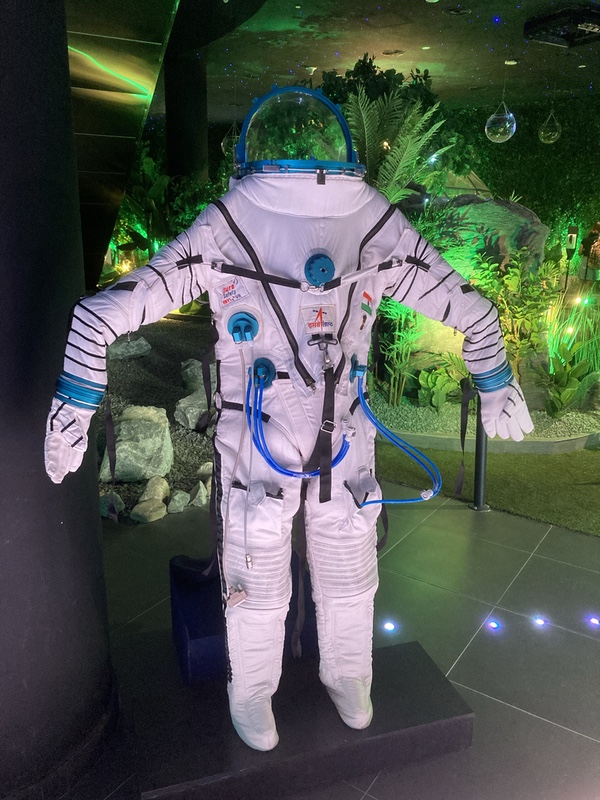 India has on display a spaesuit from its new human spaceflight program. (credit: J. Foust) |
Other countries also offer prominent displays of their space capabilities. Not far from the US pavilion is India’s. One of the first things you see stepping inside is an array of models of Indian spacecraft and launch vehicles, from remote sensing satellites and the Mangalyaan Mars orbiter to the PSLV and GSLV rockets. There’s also a nod to the near future as well: a spacesuit like that Indian astronauts will wear when the country makes it first crewed launch, likely in 2023. A room upstairs features additional displays about those missions.
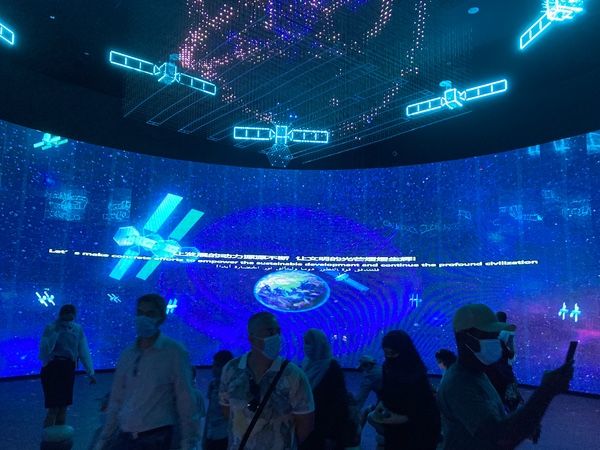 A video presentation in China’s pavilion includes spaceflight illustrations as a message to “continue the profound civilization”. (credit: J. Foust) |
Space is also a major element of China’s pavilion. Visitors go past small models of Chinese Chang’e lunar landers and the Tianwen-1 Mars mission before entering a room with a video presentation that includes Beidou navigation satellites, the Chang’e-5 lunar sample return mission, and Zhurong Mars rover. It ends with an animation of an astronaut spacewalking outside China’s space station among with the message, “There is no end in exploring the infinite universe… Let’s make concrete efforts to empower the sustainable development and continue the profound civilization.” Sustainable development of what, and which profound civilization, is left as an exercise for the viewer.
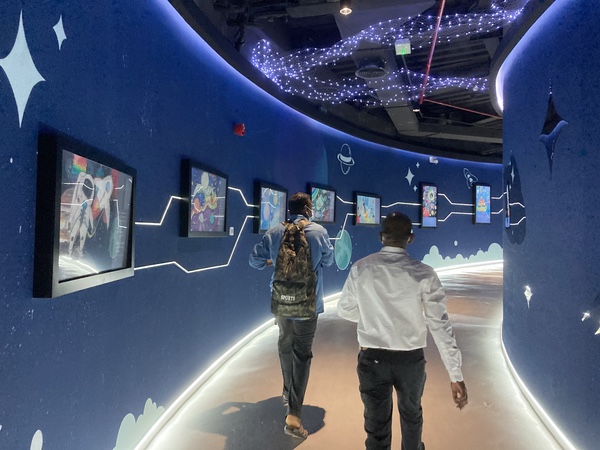 A hallway in the Chinese pavilion features student artwork about space. (credit: J. Foust) |
Exiting the video presentation, visitors go up a long, curving hallway. Along the walls of that hallway is a collection of space-themed art by Chinese children. With the exception of the Chinese characters, as well as Chinese flags and related symbols, it’s not that different than space-themed art that children in America or elsewhere might create.
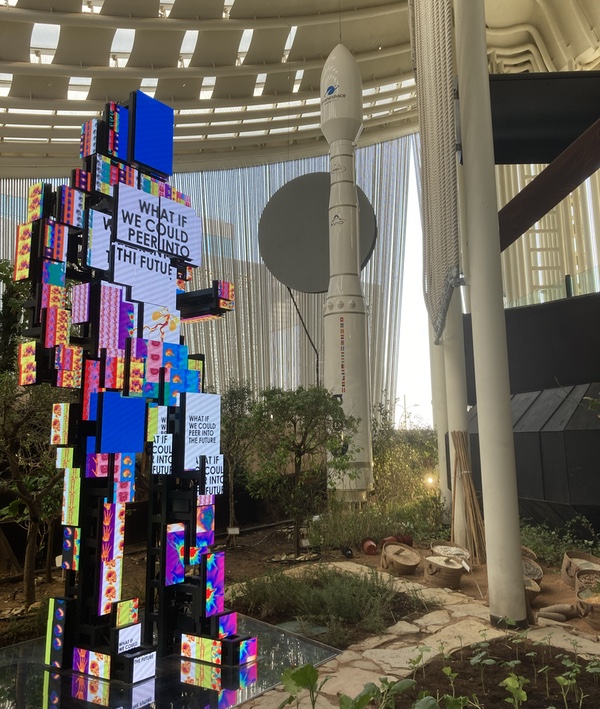 If you peer into the future at Italy’s pavilion you’ll see… a model of a Vega rocket. (credit: J. Foust) |
Space makes cameo appearances in some European pavilions. Italy’s has a model of the Vega rocket in the background of one area. Switzerland shows off a video of ClearSpace-1, a spacecraft under development by a Swiss startup to remove a launch adapter left in orbit from a Vega launch as a demonstration of orbital debris removal technologies. An exhibit outside Belgium’s pavilion honors astronaut Frank De Winne, while France has on display a spacesuit worn by astronaut Thomas Pesquet on his first trip to space on a Soyuz. (At the time of the visit Pesquet was in space again, near the end of the Crew-2 mission to the space station.)
 A display in a pavilion dedicated to transportation includes heroic astronauts and rockets flying overhead. (credit: J. Foust) |
Not all the pavilions are associated with countries. One, called Alif, is devoted to mobility, and includes all forms of transportation. A mural running along one wall shows progress in transportation, concluding with heroic astronauts walking on a planetary surface as rockets race overhead. The exhibit also includes a model of Hope, the UAE’s first Mars orbiter.
Not every major spacefaring nation included space in their Expo 2020 pavilions. Russia built a large pavilion for the expo, but there’s nothing about space to be found inside. Instead, the pavilion, built to honor the creative mind and interconnected world, is dominated by a large brain and a light show.
The above is not necessarily an exhaustive list of space exhibits at Expo 2020, for the simple reason that it’s impossible to see everything in a single day, all that was available for this reviewed after spending a week covering the International Astronautical Congress in Dubai. It does, though, demonstrate how space achievements, past and future, have integrated themselves into society, and how countries use them as symbols of who they are, or least who they present themselves to be.
Note: we are using a new commenting system, which may require you to create a new account.